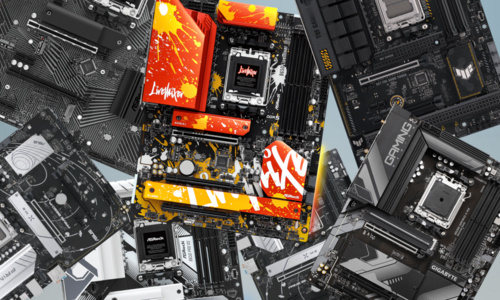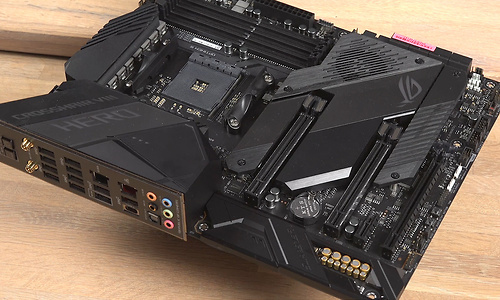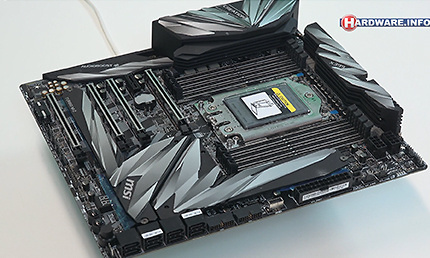Specificaties
Op bovenstaande foto vallen uiteraard meteen de 6 PCI-sloten en de 4 DIMM-sloten op. Ook opvallend is het blok dipswitches: ASUS heeft als enige fabrikant de keuze voor instelling geheel aan de klant over gelaten. De processorinstellingen zijn dus ofwel met dipswitches te maken, ofwel in de BIOS (hiervoor moeten alle dipswitches op 0 worden gezet). Dit lijkt mij een zeer verstandige oplossing: personen die graag aan hun computer tweaken kunnen gebruik maken van de softwareoplossing, maar personen met minder verstand van een computer kunnen hun moederbord door bijv. hun computerwinkel ook met de dipswitches laten instellen. De kans op instellingsfouten wordt daarmee zeer verkleind. Ook bij de ASUS P3B zien we de hippe PC99 conrectorkleurtjes.
Hieronder staan de specificaties van het moederbord, zoals de fabrikant die opgeeft. Helaas hebben we ze deze keer niet naar het Nederlands vertaald:
|
Specifications
|
|
|
Multi-Speed
|
Supports Intel Pentium® III (450MHz and faster), Pentium® II (233MHz to 450MHz), CeleronTM (266MHz and faster) processors. |
|
Intel®
AGPSet
|
Features Intel's 440BX AGPSet with I/O subsystems and front-side bus (FSB) platform, which boosts the traditional 66MHz external bus speed to 100MHz. |
|
Multi-Cache
|
Supports processors with either 512, 128, or 0KB Pipelined Burst Level 2 cache. |
|
PC-100 Memory Support
|
Equipped with four DIMM sockets to support Intel PC100-compliant SDRAMs (8,16,32,64,128, or 256MB) up to 1024MB. These new SDRAMs are necessary to meet the critical enhanced 100MHz bus speed requirement. |
|
JumperFreeTM BIOS
|
Allows processor settings and easy overclocking of frequency and Vcore voltages all through BIOS setup when JumperFreeTM mode is enabled. Easy-to-use DIP switches instead of jumpers are provided to manually setup the processor. |
|
Smart
BIOS
|
2Mb firmware provides Vcore and CPU/SDRAM frequency adjustments, boot block write protection, and HD/SCSI/MO/ZIP/CD/Floppy boot selection. Power supply is auto- detected to enable/disable Suspend-To-RAM and KB / PS/2 mouse power up, eliminating the need to make jumper adjustments. |
|
Multi-device Wake Up
|
Supports modem wake up, keyboard / PS/2 mouse wake up, and LAN card wake up functions from sleep or soft-off mode. |
|
PC Health Monitoring
|
Provides an easier way to examine and manage system status information such as CPU and system voltages, temperatures, and fan status through the onboard hardware ASIC and the bundled LDCM from Intel® or PC Probe from Asus. |
|
Enhanced ACPI & Anti-Boot Virus Protection
|
Programmable BIOS (flash EEPROM), offering enhanced ACPI for Windows 98 compatibility, built-in firmware-based virus protection, and auto-detection of most devices for virtually automatic setup. |
|
AGP Slot
|
Supports an Accelerated Graphics Port card for high performance, component level interconnect targeted 3D graphical display applications using a 1X or 2X mode bus. |
|
SMBus
|
Features the System Management Bus interface, which is used to physically transport commands and information between SMBus devices. |
|
PCI & ISA Expansion Slots
|
Provides options of five 32-bit PCI (rev 2.2) with two 16-bit ISA expansion slots, six PCI with one ISA, and six PCI with no ISA. All PCI slots can support Bus Master PCI cards, such as SCSI or LAN cards. (PCI supports up to 133MB/s maximum throughput.) |
|
Multi-I/O
|
Provides two high-speed UART compatible serial ports and one parallel port with EPP and ECP capabilities. UART2 can also be directed from COM2 to the Infrared Module for wireless connections. |
|
Ultra DMA/33 Bus Master IDE
|
Comes with an onboard PCI Bus Master IDE controller with two connectors that support four IDE devices in two channels. Supports UltraDMA/33, PIO Modes 3 and 4, and Bus Master IDE DMA Mode 2, as well as Enhanced IDE devices, such as Tape Backup, CD-ROM, CD-R/W, and LS-120 drives. |
|
Universal Retention Mechanism
|
Supports a Pentium® III / II processor packaged in a Single Edge Contact Catridge (SECC2/SECC) or a CeleronTM processor packaged in a Single Edge Processor Package (SEPP). |
|
Wake-On-LAN
|
Supports Wake-On-LAN activity through an optional ASUS PCI-L101 10/100 Fast Ethernet PCI card or a similar ethernet card. |
|
Wake-On-Ring Connector
|
Supports Wake-On-Ring activity through a PCI modem card which supports a WOR connector. |
|
IrDA
|
Supports an optional infrared port module for a wireless interface. |
|
Onboard LED
|
The onboard LED will light up when there is standby power to the PCI bus. This acts as a reminder to the user to turn OFF the power before plugging and unplugging devices so as not to damage the motherboard, peripherals, and/or components. |
|
Desktop
Management Interface (DMI)
|
Supports DMI through BIOS, which allows hardware to communicate within a standard protocol creating a higher level of compatibility, (Requires DMI-enabled components.) |
|
Special
Features
|
|
|
ACPI
Ready
|
Advanced Configuration Power Interface (ACPI) provides more Energy Saving Features for operating systems that support OS Direct Power Management (OSPM) functionality. With these features implemented in the OS, PCs can be ready around the clock, yet satisfy all the energy saving standards. To fully utilize the benefits of ACPI, an ACPI-supported OS such as Windows 98 must be used. |
|
Suspend
and Go!
|
Suspend-to-RAM (STR) provides maximum power savings (average of 5 watts) as an alternative to leaving the computer ON and QuickStartTM so that you do not fall asleep waiting for system bootup (Suspend-to-RAM requires OS support and does not support ISA cards; ISA cards may fail to work coming out of STR mode). |
|
Easy
Installation
|
Incorporates BIOS that supports auto-detection of hard disk drives, PS/2 mouse, and Plug and Play devices to make the setup of hard disk drives, expansion cards, and other devices virtually automatic. |
|
PC'
99 Compliant
|
Both the BIOS and hardware levels of ASUS motherboards meet PC' 99 compliancy. The new PC' 99 requirements for systems and components are based on the following high-level goals: Support for Plug and Play compatibility and power management for configuring and managing all system components, and 32-bit device drivers and installation procedures for Windows 95/98/NT. Color-coded connectors and descriptive icons make identification easy as required by PC '99. |
|
Symbios SCSI BIOS
|
Supports optional ASUS SCSI controller cards through the onboard SYMBIOS firmware. |
|
Performance
Features
|
|
|
Concurrent PCI
|
This allows multiple PCI transfers from PCI master buses to the memory and processor. |
|
Double the IDE Transfer Speed
|
ASUS smart series motherboards with Intel® chipsets improves IDE transter rate using Bus Master UltraDMA/33 IDE which can handle data transfer up to 33MB/s. |
|
SDRAM Optimized Performance
|
Supports the new generation memory - Synchronous Dynamic Random Access Memory (SDRAM) which increases the data transfer rate to 800MB/s max using PC100-compliant SDRAM. |
|
Intelligence
|
|
|
Auto Fan Off
|
The system fans will power off automatically even in sleep mode. This function reduces both energy consumption and system noise, and is an important feature in implementing silent PC systems. |
|
Dual Function Power Button
|
Pushing the power button for less than 4 seconds when the system is in the working state places the system into one of two states: sleep mode or soft-off mode, depending on the BIOS or OS setting. When the power button is pressed for more than 4 seconds, the system enters the soft-off mode regardless of the BIOS setting. |
|
Fan Status Monitoring and Alarm
|
To prevent system overheat and system damage, the CPU, power supply, and system fans can be monitored for RPM and failure. All fans are set for its normal RPM range and alarm thresholds. |
|
PS/2 Keyboard/Mouse Power Up
|
Keyboard/Mouse Power Up can be enabled or disabled to allow the computer to be powered on by pressing the space bar on the keyboard or moving the mouse. |
|
Message LED (requires ACPI OS Support)
|
Turbo LEDs now act as information providers. Through the way a particular LED illuminates, the user can determine if there are messages waiting in the mailbox. A simple glimpse provides useful information to the user. |
|
Remote Ring On (requires external modem)
|
This allows a computer to be turned on remotely through an external modem. With this benefit on-hand, any user can access vital information from their computer from anywhere in the world! |
|
System Resources Alert
|
Today's operating systems such as Windows 95/98/NT and OS/2, require much more memory and hard drive space to present enormous user interfaces and run large applications. The system resource monitor will warn the user before the system resources are used up to prevent possible application crashes. Suggestions will give the user information on managing their limited resources more efficiently. |
|
Temperature Monitoring and Alert
|
CPU temperature is monitored by the ASUS ASIC thruough the CPU's internal thermal diode (on Pentium III, Deschutte Pentium II, and PPGA370 Celeron in conjunction with the ASUS S370-D or S370-L transform card) to prevent system overheat and system damage. |
|
Voltage Monitoring and Alert
|
System voltage levels are monitored to ensure stable voltage o critical motherboard components. Voltage specifications are more critical for future processors, so monitoring is necessary to ensure proper system configuration and management. |
|
Chassis Intrusion Detection
|
Supports chassis-intrusion monitoring through the optional ASUS CIDB module and Intel® LDCM. |
Op de volgende pagina zullen we op enkele specificatie punten wat dieper in gaan.











